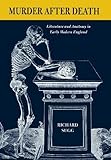Murder after Death : Literature and Anatomy in Early Modern England / Richard Sugg.
Material type: TextPublisher: Ithaca, NY : Cornell University Press, [2018]Copyright date: ©2007Description: 1 online resource (280 p.) : 1 table, 13 halftonesContent type:
TextPublisher: Ithaca, NY : Cornell University Press, [2018]Copyright date: ©2007Description: 1 online resource (280 p.) : 1 table, 13 halftonesContent type: - 9781501729973
- 820.9/3561 22
- PR428.H78
- online - DeGruyter
| Item type | Current library | Call number | URL | Status | Notes | Barcode | |
|---|---|---|---|---|---|---|---|
 eBook
eBook
|
Biblioteca "Angelicum" Pont. Univ. S.Tommaso d'Aquino Nuvola online | online - DeGruyter (Browse shelf(Opens below)) | Online access | Not for loan (Accesso limitato) | Accesso per gli utenti autorizzati / Access for authorized users | (dgr)9781501729973 |
Frontmatter -- CONTENTS -- List of Illustrations -- Acknowledgments -- Introduction: The Invading Body -- 1. Between the Skin and the Bone: Anatomy, Violence, and Transition -- 2. "I'll eat the rest of th'anatomy": Dissection and Cannibalism -- 3. The Body as Proof -- 4. The Split Body -- 5. Vivisection, Violence, and Identity -- Conclusion: The Anatomy of the Soul -- Appendix 1. English Literary Anatomies to 1650 -- Appendix 2. Anatomy Allusions in Dated London Sermons to 1642 -- List of Abbreviations -- Notes -- Index
restricted access online access with authorization star
http://purl.org/coar/access_right/c_16ec
Just as museum exhibits of plastinated corpses, television dramas about forensics, and books about the eventual fate of human remains provoke interest and generate ethical debates today, anatomy was a topic of fascination-and autopsies a spectator pastime-in England from the mid-Elizabethan era through the outbreak of civil war. Rather than regard such preoccupations as purely macabre, Richard Sugg sees them as precursors of a profoundly new scientific and cultural discourse.Tracing the influence of continental anatomy on English literature across the period, Sugg begins his exploration with the essentially sacralizing aspects of dissection—as expressed, for instance, in the search for the anatomical repository of the soul—before detailing ways in which science and religion diverged from and eventually opposed each other. In charting this transition, Sugg draws his evidence from the fine detail of literary language, moving from sermons to plays, medical textbooks to sonnets, and from sensational short tales to Thomas Nashe's proto-novel The Unfortunate Traveller.As Sugg shows, the study of anatomy first offered to positively revitalize many areas of religious rhetoric. In time, however, the rising forces of early scientific enquiry transformed the body into an increasingly alien and secular entity. Within this evolution the author finds a remarkably rich, subtle, and unstable set of attitudes, with different forms of violence, different versions of the interior body, and implicit social, religious, and psychological stances variously cooperating or competing for supremacy.
Mode of access: Internet via World Wide Web.
In English.
Description based on online resource; title from PDF title page (publisher's Web site, viewed 26. Apr 2024)


